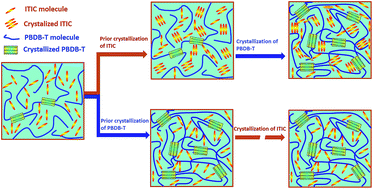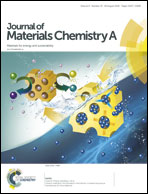Reducing the confinement of PBDB-T to ITIC to improve the crystallinity of PBDB-T/ITIC blends†
Abstract
The ordered aggregation of non-fullerene small molecular acceptors (SMAs) plays a key role in determining the charge transport and bimolecular recombination in polymer/SMA solar cells. However, due to the competition between crystallization and phase separation, the polymers are prone to form a network first, which inhibits the molecular diffusion of SMAs, resulting in weak crystallinity of SMAs. Here, we demonstrated a sequential crystallization method for high performance PBDB-T/ITIC solar cells with much improved crystallinity of ITIC. By tuning the sequence of thermal annealing (TA) and solvent vapor annealing (SVA), sequential crystallization of ITIC and PBDB-T can be fine controlled to grow a highly crystalline ITIC and PBDB-T network. The crystallization kinetics results indicate that when the crystallization of ITIC occurred prior to the formation of the PBDB-T crystallized network, the crystallinity of ITIC is significantly improved due to high molecular diffusion. However, if the crystallization of PBDB-T occurred first, the diffusion of ITIC was restricted by the crystalline network of PBDB-T, resulting in a low crystallinity of ITIC. The enhanced crystallinity of ITIC is beneficial to the electron transport and suppressed the bimolecular recombination, which helps boost the device performance from 8.14% to 10.95%. This work demonstrates that manipulation of the crystallization sequence of the donor and acceptor may be key to further boost the efficiency of polymer/SMA solar cells.



 Please wait while we load your content...
Please wait while we load your content...